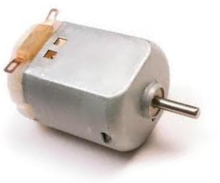DC Motor Specifications- Explained

DC motors come with a variety of specifcations, including RPM, no-load speed, maximum current load, and stall torque.
These are all specifications which you find on a datasheet for a DC motor, but what do these terms mean?
In this article, we go over what these terms mean so that you can better understand them when reviewing a DC motor
datasheet. Understanding them can help you choose a more appropriate DC motor for an engineering project.
DC Motor Specifications
RPM
No-load Speed
Stall Torque
Maximum Current
RPM (Revolutions per minute)
RPM is one of the most important specifications of a DC motor. RPM, which stands for revolutions per minute, is the amount of times the shaft of a DC motor completes a full spin cycle per minute. A full spin cycle is when the shaft turns a full 360°. The amount of 360° turns, or revolutions, a motor does in a minute is its RPM value. So a motor with an RPM of 24,000 is much more high speed than a motor which has 2400RPM. RPM is important when you need the motor to spin a certain number of times in a given time period. When speed is important, RPM is a crucial factor to look over when choosing a motor. In certain high-speed applications, it is imperative that motors that have high RPM are chosen. This may include applications such as washing machines with high-speed rinse cycles, treadmills that reach high speeds, and any such applications.
Usually when the RPM value for a motor is specified, it normally is given with the voltage that will make it make that amount of
turns per minute, such as 2400RPM @ 3V. Thus, the motor will spin 2400 times per minute when fed 3 volts DC into it.
No-load Speed
The no-load speed of a DC motor is the speed that the DC motor will turn when nothing is attached to its shaft. This is why it is called no load. The DC motor isn't loaded with an object.
When a DC motor has nothing attached to its shaft, it is able to operate at its highest maximum speed. When it is then loaded with an object on its shaft, its speed will decrease. This is because it now has to bear with the weight of an object on it.
The no-load speed serves as a reference to how fast the shaft of a motor will turn before weight is added to it. Thus, a circuit designer can have a frame of reference.
The RPM value of a motor that will be specified will normally be the no-load speed.
Stall Torque
Stall torque is the torque produced on a motor when the output rotational speed is zero. This is why it is called the stall torque. It stalls the shaft of the motor, so that it longer spins and has rotational motion. This occurs when the torque load is either equal to or greater than the motor shaft torque. In this condition, the motor draws maximum current but does not rotate.
Electric motors are devices which continue to provide torque when stalled. It's the same as a situation where a machinery is trying to lift up an object that is too heavy to lift. Though the object can't be lifted because it's too heavy, the machinery is still exerting force on it (to try to get it to lift up). This is the same with motors. If too much weight is applied to the shaft, more load than it can handle, the motor will not be able to sufficiently rotate.
So stall torque has to do with the amount of weight a motor shaft can handle before it stalls. For this reason, stall torque is specified as g∙cm. This is the amount of grams of weight that a motor shaft can withstand per centimeter (cm) of its length. An example of a stall torque of a motor is 36 g∙cm. So the motor shaft has more than 36 g∙cm on its shaft, it will stall. Below this weight, it will have more torque than the load and, thus, will be able to rotate.
Stall torque is a very important specification of a motor when weight on a shaft is important. If a circuit designer is only going to
put a lightweight object on the motor's shaft, it isn't such a concern. If the designer is going to place a heavy item on the shaft, then
it plays a huge role. The designer must be able to know whether that motor can handle that type of weight and still rotate. For motors
spinning heavy objects, much more powerful motors must be used.
Maximum Current
The maximum current specification of a motor is the maximum amount of current that a motor can withstand passing through it without being damaged or destroyed.
So the maximum current is a power restraint that circuit designer must make sure is not exceeded.
An example of a maximum current specification of a 9V DC motor is 115mA. This means the motor cannot be fed more than
115mA.
Related Resources
How to Build a DC Motor Circuit